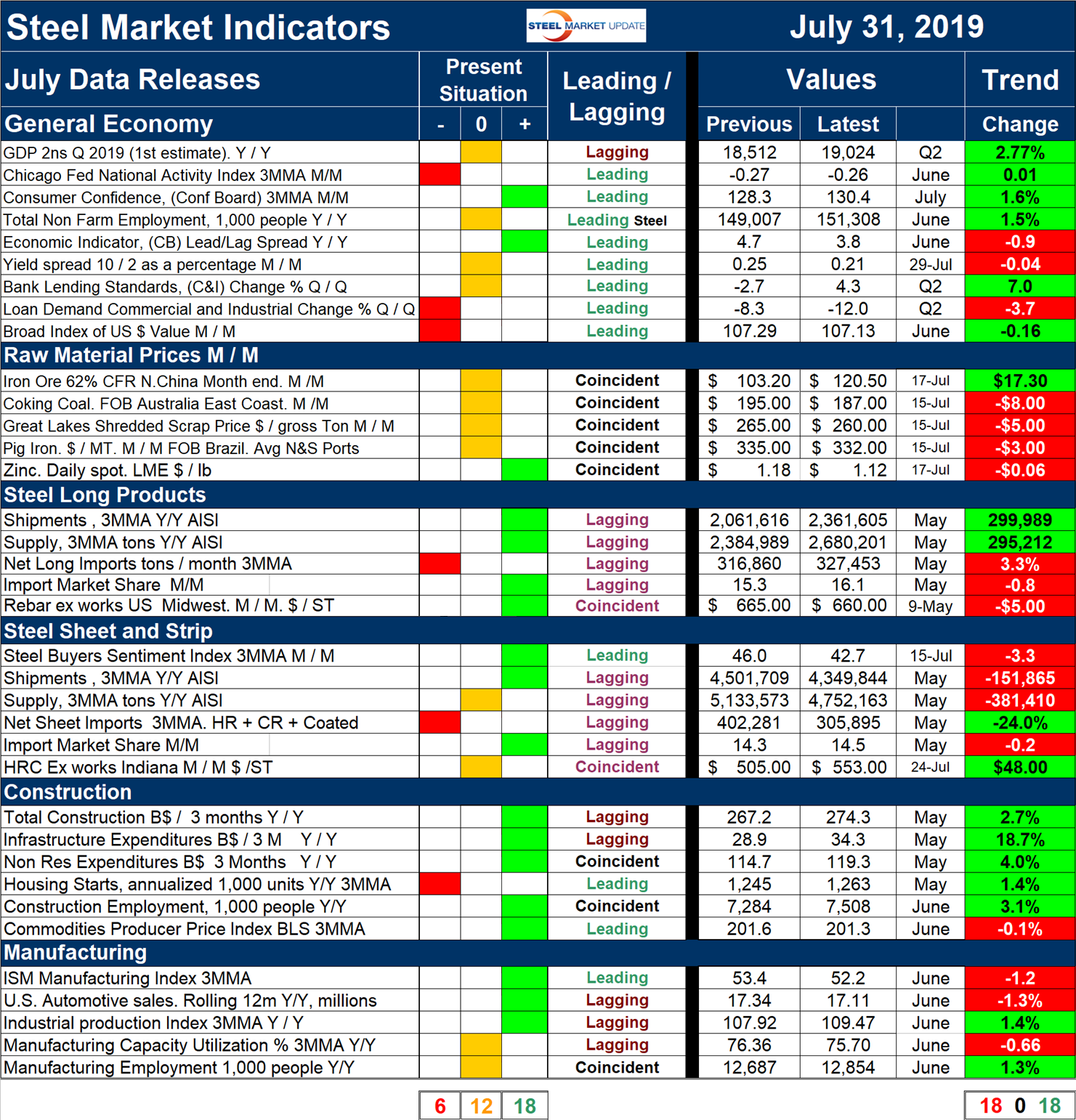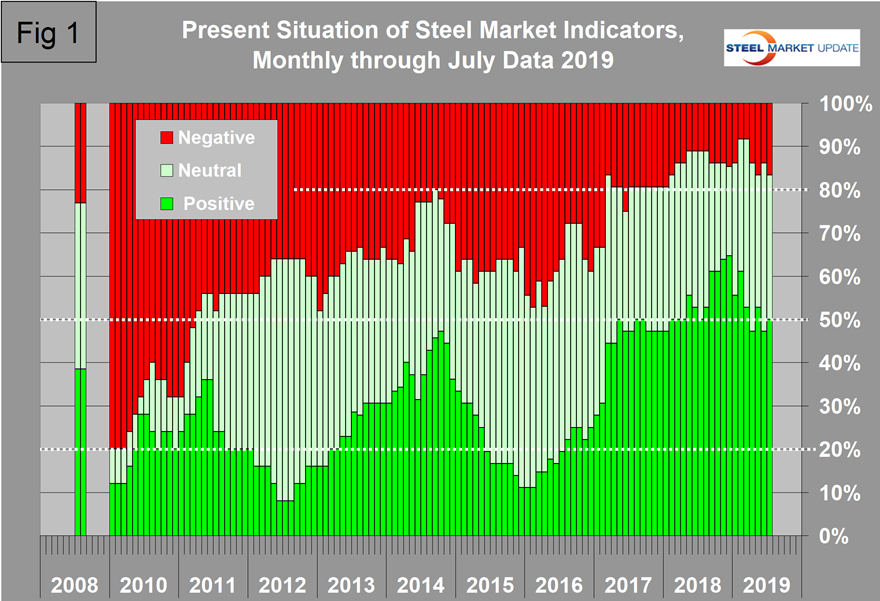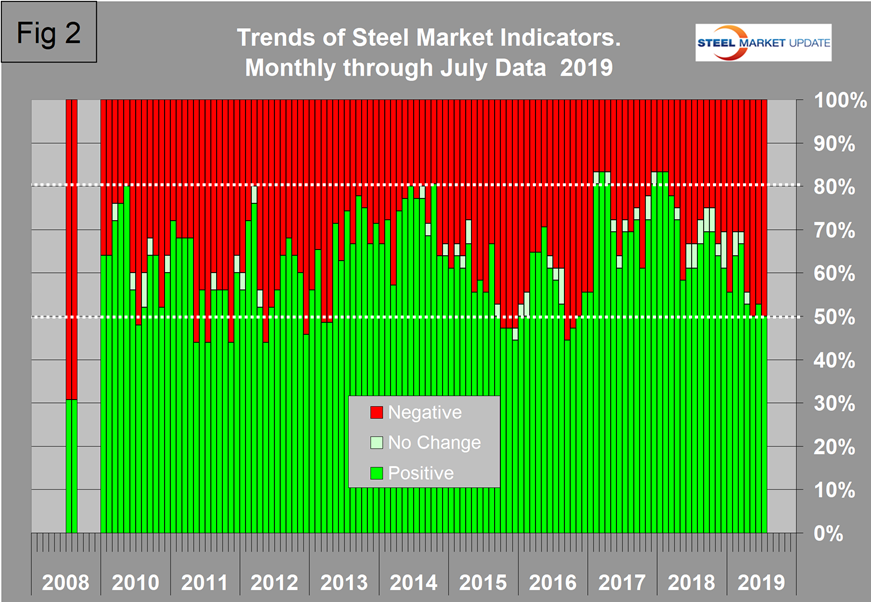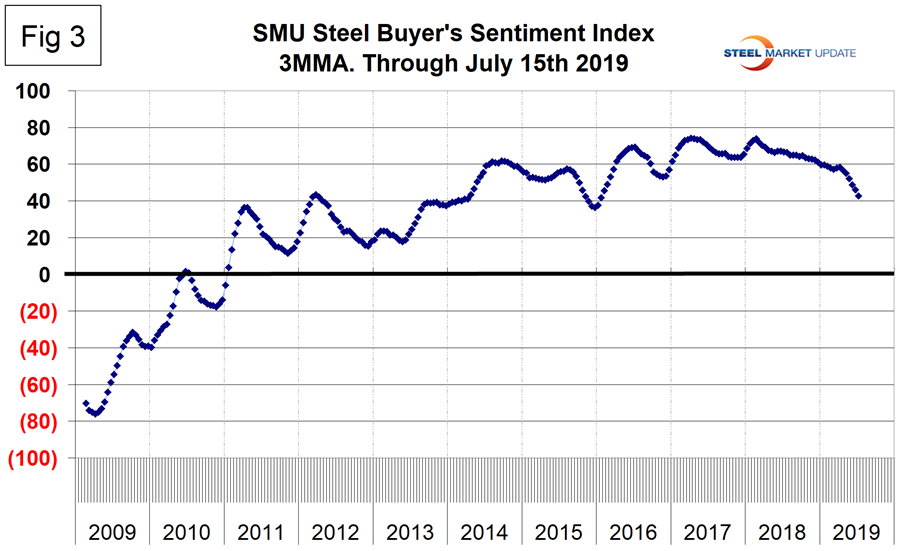Market Data

August 2, 2019
SMU Analysis: Key Market Indicators
Written by Peter Wright
Steel Market Update’s analysis of Key Market Indicators shows the present market situation was basically unchanged in the last month, based on data released in July, but half the 36 indicators trended positive and half negative.
This report is designed to be a big picture summary of data on which we have reported in detail during the month. In it we summarize 36 data streams that critically describe the state of the steel market and provide forward guidance for steel buyers and sellers. See the end of this piece for an explanation of the Key Indicators concept. This will explain the difference between our view of the present situation, which is subjective, and our analysis of trends, which is based on the latest facts available.
Please refer to Table 1 for our view of the present situation and the quantitative measure of trends. Readers should regard the color codes in the present situation column as a visual summary of the current market condition. The “Trend” columns of Table 1 are also color coded to give a quick visual appreciation of the direction the market is headed. All results are the latest available as of July 31, 2019.

Present Situation
Our view of the July data is that the number of indicators we regard as strong has been hovering around 50 percent for the last four months with only 17 percent being weak. The balance, 33 percent, are in the historical mid-range (normal). Figure 1 shows the history of our view of the present situation data since January 2010 on a percentage basis, and on the far left of the chart is the August 2008 situation immediately before the recession struck the steel business in September that year. Our view of the July data is that of the 36 indicators, 18 are currently positive, 12 are normal and six are negative. This was a decrease of two in the number of indicators that we consider normal, and an increase of one negative and one positive since our June update. Our intent in using the word normal is to say that this indicator is in the mid-range of historical data. Since the end of June, our view of growth of GDP in the U.S. changed from positive to normal based on the first estimate for the second quarter of 2019. Data for the Chicago Fed National Activity Index flipped back from normal to negative, which is where it was in May. In the sheet and strip section of Table 1, both shipments and import market share improved from normal to positive. There were no changes in the raw materials, the long products steel section or in the construction and manufacturing sections.

Trends
Most values in the trends columns are three-month moving averages (3MMA) to smooth out what can be very erratic monthly data. Trend changes in the individual sectors are described below together with some general comments. (Please note that in most cases this is not July data but data that was released in July for previous months.)
Figure 2 shows the trend of the trends and the pre-recession situation at the far left of the chart. In July 2019, 18 indicators were trending positive and 18 negative. May and July were the first months for the proportion trending positive to fall to 50 percent since November 2016. Nine indicators reversed direction in the July data resulting in a net increase of one negative and a net decrease of one positive. Noting the changes, the Conference Board Leading Economic Indicator, the yield spread, net long product imports, long product import market share and the producer price index of commodities all flipped from trending positive to trending negative. Consumer Confidence, the Broad Index value of the U.S. dollar, price of hot rolled coil ex works Indiana and housing starts reversed direction from a negative to a positive trend. There has been a gradual deterioration in the number of positively trending indicators since February 2018.

There were no trend reversals in the raw materials and manufacturing sections of the report. Five of the six construction indicators are trending positive and three of the five manufacturing indicators are trending negative.
As a reality check for this report, we include here Figure 3, which is SMU’s Steel Buyers Sentiment Index. Readings are developed during the twice monthly SMU market surveys. SMU Steel Buyers Sentiment is a measure of the current attitude of North American buyers and sellers of flat rolled products regarding their company’s opportunity for success in today’s market. A reading above the neutral point of zero indicates that a preponderance of buyers have a positive attitude. The index has been deteriorating since mid-February last year. The mid-July value was still positive 42.7, but down from a peak of 73.8 in February 2018.

We believe a continued examination of both the present situation and direction is a valuable tool for corporate business planning. Figures 1 and 2 both show the pre-recession situation in August 2008. The trends analysis shows that the steel market was going over a cliff, but the actual values of the indicators at that time were still good with only 23 percent registering as historically negative.
Explanation: The point of this analysis is to give both a quick visual appreciation of the market situation and a detailed description for those who want to dig deeper. It describes where we are now and the direction the market is headed and is designed to describe the situation on a specific date. The chart is stacked vertically to separate the primary indicators of the general economy, of raw material prices, of both sheet and long product market indicators, and of construction and manufacturing indicators. The indicators are classified as leading, coincident or lagging as shown in the third column.
Columns in the chart are designed to differentiate between where the market is today and the direction it is pointing. Our evaluation of the present situation is subjectively based on our opinion of the historical value of each indicator. There is nothing subjective about the trends section, which provides the latest facts available on the date of publication. It is quite possible for the present situation to be predominantly red and trends to be predominantly green or vice versa depending on the overall situation and direction of the market. The present situation is subdivided into: below the historical norm (-), (OK), and above the historical norm (+). The “Values” section of the chart is a quantitative definition of the market’s direction. In most cases, values are three-month moving averages to eliminate noise. In cases where seasonality is an issue, the evaluation of market direction is made on a year-over-year comparison to eliminate this effect. Where seasonality is not an issue, concurrent periods are compared. The date of the latest data is identified in the third values column. Values will always be current as of the date of publication. Finally, the far-right column quantifies the trend as a percentage or numerical change with color code classification to indicate positive or negative direction.







